Lesson Planning: Teaching Strategies for TESOL
VerifiedAdded on 2023/02/01
|16
|3424
|56
AI Summary
This lesson plan focuses on teaching strategies for TESOL, specifically on the topic of comparison shopping in Economics. It incorporates TESOL teaching strategies, language and literacy skills, and relevant curriculum outcomes. The plan emphasizes the use of scaffolding, meta-language support, and multimodal representations to enhance student learning. The lesson plan also addresses the challenges of diversity in the classroom and provides guidance for teachers to support students with English as an additional language or dialect. The plan includes interactive discussion sessions, practical activities, and the use of ICT tools for effective teaching and learning.
Contribute Materials
Your contribution can guide someone’s learning journey. Share your
documents today.
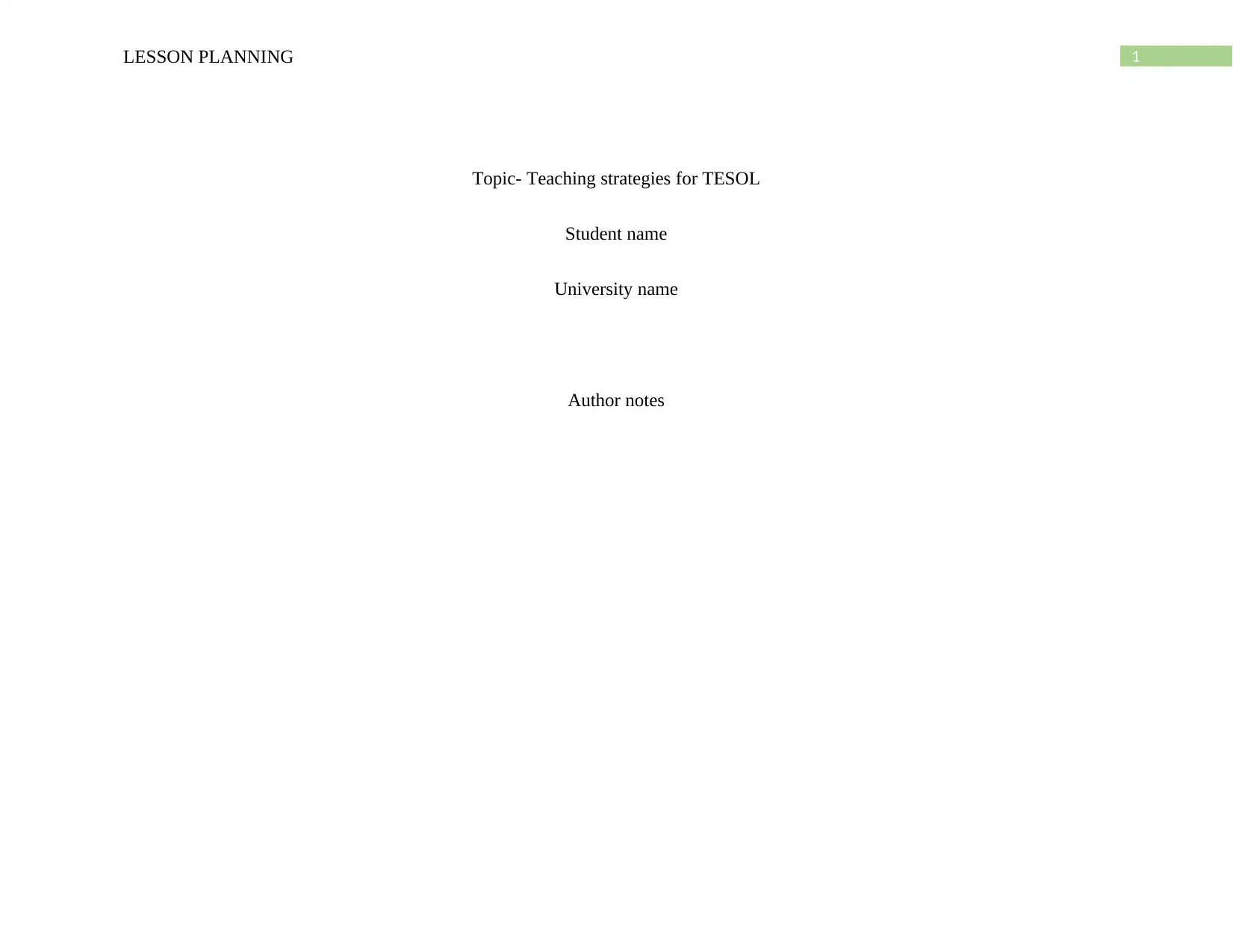
1LESSON PLANNING
Topic- Teaching strategies for TESOL
Student name
University name
Author notes
Topic- Teaching strategies for TESOL
Student name
University name
Author notes
Secure Best Marks with AI Grader
Need help grading? Try our AI Grader for instant feedback on your assignments.
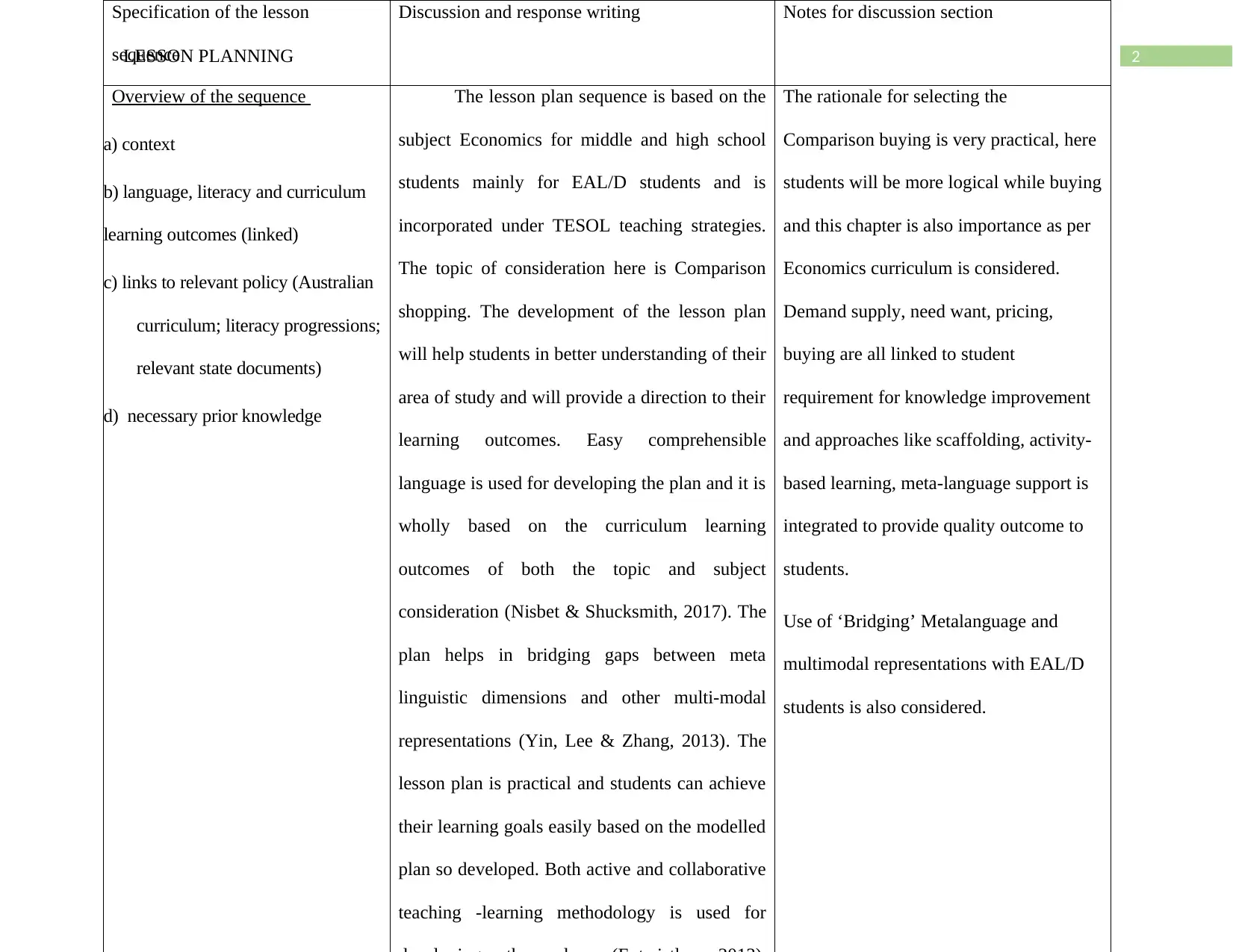
2LESSON PLANNING
Specification of the lesson
sequence
Discussion and response writing Notes for discussion section
Overview of the sequence
a) context
b) language, literacy and curriculum
learning outcomes (linked)
c) links to relevant policy (Australian
curriculum; literacy progressions;
relevant state documents)
d) necessary prior knowledge
The lesson plan sequence is based on the
subject Economics for middle and high school
students mainly for EAL/D students and is
incorporated under TESOL teaching strategies.
The topic of consideration here is Comparison
shopping. The development of the lesson plan
will help students in better understanding of their
area of study and will provide a direction to their
learning outcomes. Easy comprehensible
language is used for developing the plan and it is
wholly based on the curriculum learning
outcomes of both the topic and subject
consideration (Nisbet & Shucksmith, 2017). The
plan helps in bridging gaps between meta
linguistic dimensions and other multi-modal
representations (Yin, Lee & Zhang, 2013). The
lesson plan is practical and students can achieve
their learning goals easily based on the modelled
plan so developed. Both active and collaborative
teaching -learning methodology is used for
The rationale for selecting the
Comparison buying is very practical, here
students will be more logical while buying
and this chapter is also importance as per
Economics curriculum is considered.
Demand supply, need want, pricing,
buying are all linked to student
requirement for knowledge improvement
and approaches like scaffolding, activity-
based learning, meta-language support is
integrated to provide quality outcome to
students.
Use of ‘Bridging’ Metalanguage and
multimodal representations with EAL/D
students is also considered.
Specification of the lesson
sequence
Discussion and response writing Notes for discussion section
Overview of the sequence
a) context
b) language, literacy and curriculum
learning outcomes (linked)
c) links to relevant policy (Australian
curriculum; literacy progressions;
relevant state documents)
d) necessary prior knowledge
The lesson plan sequence is based on the
subject Economics for middle and high school
students mainly for EAL/D students and is
incorporated under TESOL teaching strategies.
The topic of consideration here is Comparison
shopping. The development of the lesson plan
will help students in better understanding of their
area of study and will provide a direction to their
learning outcomes. Easy comprehensible
language is used for developing the plan and it is
wholly based on the curriculum learning
outcomes of both the topic and subject
consideration (Nisbet & Shucksmith, 2017). The
plan helps in bridging gaps between meta
linguistic dimensions and other multi-modal
representations (Yin, Lee & Zhang, 2013). The
lesson plan is practical and students can achieve
their learning goals easily based on the modelled
plan so developed. Both active and collaborative
teaching -learning methodology is used for
The rationale for selecting the
Comparison buying is very practical, here
students will be more logical while buying
and this chapter is also importance as per
Economics curriculum is considered.
Demand supply, need want, pricing,
buying are all linked to student
requirement for knowledge improvement
and approaches like scaffolding, activity-
based learning, meta-language support is
integrated to provide quality outcome to
students.
Use of ‘Bridging’ Metalanguage and
multimodal representations with EAL/D
students is also considered.

3LESSON PLANNING
Discussion
However, only strategy making and lesson plan development will not be purposeful for the whole class as there are students
from various diversified backgrounds. Diversity are in areas of linguistic variations, cultural variations, socio-economic variations and
religious differences (Kraft, Blazar & Hogan, 2018). But as Economics is not a language subject so diversity can be limited down and
using standard Australian English as the medium of teaching will serve the purpose. But for the students who have English as
additional language or dialect need special support to develop and access the Australian curriculum learning (Roehl, Reddy &
Shannon, 2013). In this regard teachers’ help is prioritised where they can scaffold relevant materials and learning resources to
students for better understanding of the topic. Emphasis on continuum of both reading and writing is to be provided and interaction
will help in completion of the teaching and learning cycle (TLC) (Kane, Kerr & Pianta, 2014). Though the teaching strategies need to
be varied for differently-abled students. It is quite challenging for teachers to find the best strategy and content for students with
learning disabilities. Comparison shopping is an important aspect of Business and Economics curriculum and is deeply rooted to
practical life buying experiences (Darling-Hammond, 2016). Thus, to develop lesson plan for students with learning disabilities is
important in this context. Here students may be asked to cut and paste items from product catalogues of a shopping list. Next the price
and weight should be included and the final list is to be displayed in the class. Along with the shopping list another list of comparison-
shopping tips needs to be provided that will help those students to be smart buyers and efficient shoppers ( Heitz-Spahn, 2013).
Students will learn that mere ads will not be sufficient for buying other aspects of price, value and need are also to be evaluated before
final buying.
Discussion
However, only strategy making and lesson plan development will not be purposeful for the whole class as there are students
from various diversified backgrounds. Diversity are in areas of linguistic variations, cultural variations, socio-economic variations and
religious differences (Kraft, Blazar & Hogan, 2018). But as Economics is not a language subject so diversity can be limited down and
using standard Australian English as the medium of teaching will serve the purpose. But for the students who have English as
additional language or dialect need special support to develop and access the Australian curriculum learning (Roehl, Reddy &
Shannon, 2013). In this regard teachers’ help is prioritised where they can scaffold relevant materials and learning resources to
students for better understanding of the topic. Emphasis on continuum of both reading and writing is to be provided and interaction
will help in completion of the teaching and learning cycle (TLC) (Kane, Kerr & Pianta, 2014). Though the teaching strategies need to
be varied for differently-abled students. It is quite challenging for teachers to find the best strategy and content for students with
learning disabilities. Comparison shopping is an important aspect of Business and Economics curriculum and is deeply rooted to
practical life buying experiences (Darling-Hammond, 2016). Thus, to develop lesson plan for students with learning disabilities is
important in this context. Here students may be asked to cut and paste items from product catalogues of a shopping list. Next the price
and weight should be included and the final list is to be displayed in the class. Along with the shopping list another list of comparison-
shopping tips needs to be provided that will help those students to be smart buyers and efficient shoppers ( Heitz-Spahn, 2013).
Students will learn that mere ads will not be sufficient for buying other aspects of price, value and need are also to be evaluated before
final buying.
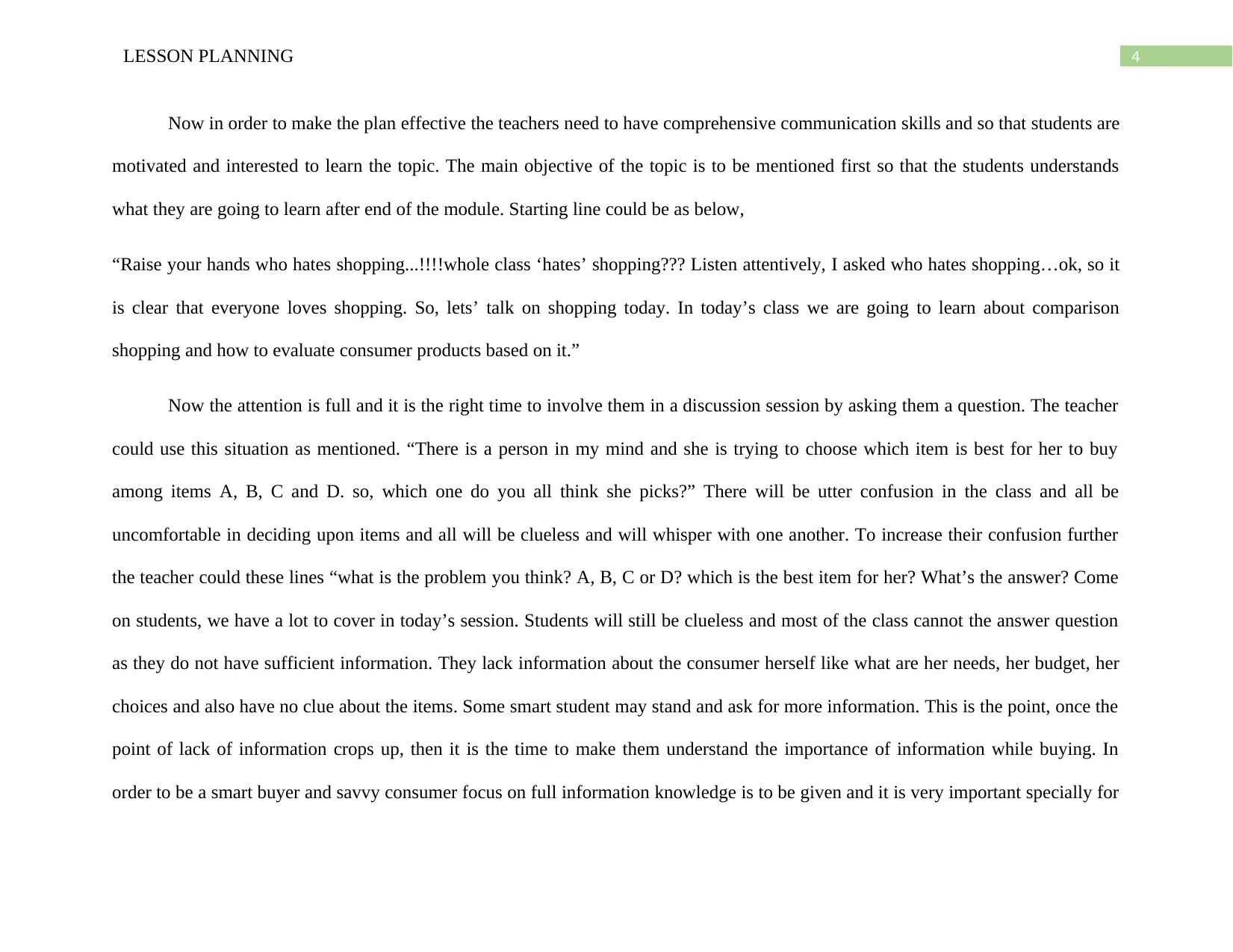
4LESSON PLANNING
Now in order to make the plan effective the teachers need to have comprehensive communication skills and so that students are
motivated and interested to learn the topic. The main objective of the topic is to be mentioned first so that the students understands
what they are going to learn after end of the module. Starting line could be as below,
“Raise your hands who hates shopping...!!!!whole class ‘hates’ shopping??? Listen attentively, I asked who hates shopping…ok, so it
is clear that everyone loves shopping. So, lets’ talk on shopping today. In today’s class we are going to learn about comparison
shopping and how to evaluate consumer products based on it.”
Now the attention is full and it is the right time to involve them in a discussion session by asking them a question. The teacher
could use this situation as mentioned. “There is a person in my mind and she is trying to choose which item is best for her to buy
among items A, B, C and D. so, which one do you all think she picks?” There will be utter confusion in the class and all be
uncomfortable in deciding upon items and all will be clueless and will whisper with one another. To increase their confusion further
the teacher could these lines “what is the problem you think? A, B, C or D? which is the best item for her? What’s the answer? Come
on students, we have a lot to cover in today’s session. Students will still be clueless and most of the class cannot the answer question
as they do not have sufficient information. They lack information about the consumer herself like what are her needs, her budget, her
choices and also have no clue about the items. Some smart student may stand and ask for more information. This is the point, once the
point of lack of information crops up, then it is the time to make them understand the importance of information while buying. In
order to be a smart buyer and savvy consumer focus on full information knowledge is to be given and it is very important specially for
Now in order to make the plan effective the teachers need to have comprehensive communication skills and so that students are
motivated and interested to learn the topic. The main objective of the topic is to be mentioned first so that the students understands
what they are going to learn after end of the module. Starting line could be as below,
“Raise your hands who hates shopping...!!!!whole class ‘hates’ shopping??? Listen attentively, I asked who hates shopping…ok, so it
is clear that everyone loves shopping. So, lets’ talk on shopping today. In today’s class we are going to learn about comparison
shopping and how to evaluate consumer products based on it.”
Now the attention is full and it is the right time to involve them in a discussion session by asking them a question. The teacher
could use this situation as mentioned. “There is a person in my mind and she is trying to choose which item is best for her to buy
among items A, B, C and D. so, which one do you all think she picks?” There will be utter confusion in the class and all be
uncomfortable in deciding upon items and all will be clueless and will whisper with one another. To increase their confusion further
the teacher could these lines “what is the problem you think? A, B, C or D? which is the best item for her? What’s the answer? Come
on students, we have a lot to cover in today’s session. Students will still be clueless and most of the class cannot the answer question
as they do not have sufficient information. They lack information about the consumer herself like what are her needs, her budget, her
choices and also have no clue about the items. Some smart student may stand and ask for more information. This is the point, once the
point of lack of information crops up, then it is the time to make them understand the importance of information while buying. In
order to be a smart buyer and savvy consumer focus on full information knowledge is to be given and it is very important specially for
Secure Best Marks with AI Grader
Need help grading? Try our AI Grader for instant feedback on your assignments.
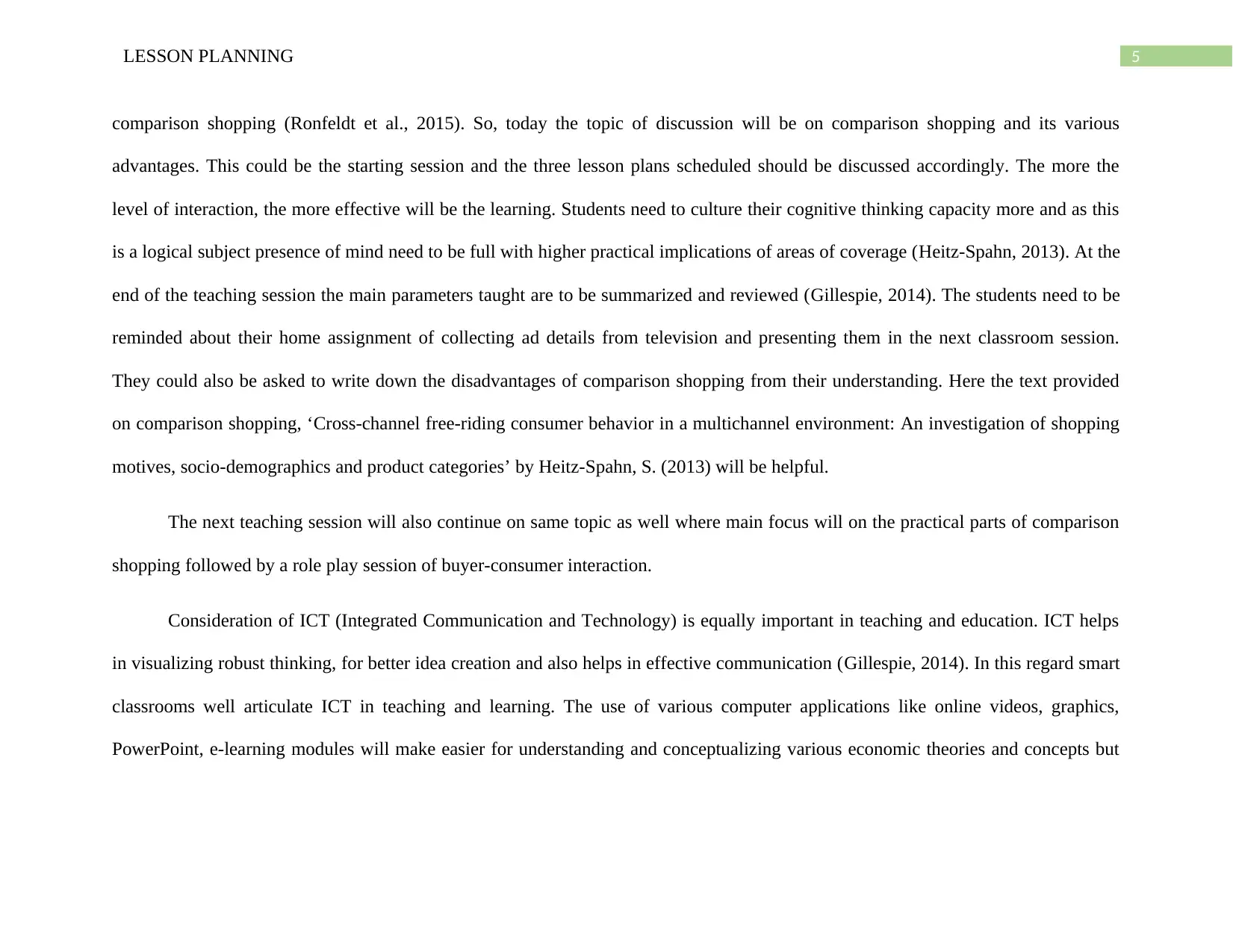
5LESSON PLANNING
comparison shopping (Ronfeldt et al., 2015). So, today the topic of discussion will be on comparison shopping and its various
advantages. This could be the starting session and the three lesson plans scheduled should be discussed accordingly. The more the
level of interaction, the more effective will be the learning. Students need to culture their cognitive thinking capacity more and as this
is a logical subject presence of mind need to be full with higher practical implications of areas of coverage (Heitz-Spahn, 2013). At the
end of the teaching session the main parameters taught are to be summarized and reviewed (Gillespie, 2014). The students need to be
reminded about their home assignment of collecting ad details from television and presenting them in the next classroom session.
They could also be asked to write down the disadvantages of comparison shopping from their understanding. Here the text provided
on comparison shopping, ‘Cross-channel free-riding consumer behavior in a multichannel environment: An investigation of shopping
motives, socio-demographics and product categories’ by Heitz-Spahn, S. (2013) will be helpful.
The next teaching session will also continue on same topic as well where main focus will on the practical parts of comparison
shopping followed by a role play session of buyer-consumer interaction.
Consideration of ICT (Integrated Communication and Technology) is equally important in teaching and education. ICT helps
in visualizing robust thinking, for better idea creation and also helps in effective communication (Gillespie, 2014). In this regard smart
classrooms well articulate ICT in teaching and learning. The use of various computer applications like online videos, graphics,
PowerPoint, e-learning modules will make easier for understanding and conceptualizing various economic theories and concepts but
comparison shopping (Ronfeldt et al., 2015). So, today the topic of discussion will be on comparison shopping and its various
advantages. This could be the starting session and the three lesson plans scheduled should be discussed accordingly. The more the
level of interaction, the more effective will be the learning. Students need to culture their cognitive thinking capacity more and as this
is a logical subject presence of mind need to be full with higher practical implications of areas of coverage (Heitz-Spahn, 2013). At the
end of the teaching session the main parameters taught are to be summarized and reviewed (Gillespie, 2014). The students need to be
reminded about their home assignment of collecting ad details from television and presenting them in the next classroom session.
They could also be asked to write down the disadvantages of comparison shopping from their understanding. Here the text provided
on comparison shopping, ‘Cross-channel free-riding consumer behavior in a multichannel environment: An investigation of shopping
motives, socio-demographics and product categories’ by Heitz-Spahn, S. (2013) will be helpful.
The next teaching session will also continue on same topic as well where main focus will on the practical parts of comparison
shopping followed by a role play session of buyer-consumer interaction.
Consideration of ICT (Integrated Communication and Technology) is equally important in teaching and education. ICT helps
in visualizing robust thinking, for better idea creation and also helps in effective communication (Gillespie, 2014). In this regard smart
classrooms well articulate ICT in teaching and learning. The use of various computer applications like online videos, graphics,
PowerPoint, e-learning modules will make easier for understanding and conceptualizing various economic theories and concepts but

6LESSON PLANNING
teachers prefer the traditional mode of teaching in Economics more instead (Voogt et al., 2013). However, basic understanding needs
to be made by using conventional method and then ICT tools will be more helpful.
Though metalanguage in economics and business is not as significant as it is in language subjects like English but still
emphasis on economics metalanguage terms like money, price, quality, product, buying, consumer and need is given here (Heitz-
Spahn, 2013). De-tracking and accelerated learning help effective learning in students and inclusion of both academic and social
support scaffold increase value of students as human beings and their attitudes, beliefs and values changes drastically with curriculum
and imbibe a sense of time management in them holistically (Beetham & Sharpe, 2013). Not only in academic learning but teachers
should focus on overall development of their students. To support diverse classroom all learning styles namely auditory, visual and
kinaesthetic should be employed by the teachers in their learning plan development (Beetham & Sharpe, 2013). Providing guided
notes in this regard will enhance the objective of scaffolding. The teachers can provide the motivated students some print outs of how
to take notes in a more comprehensive manner (John & Wheeler, 2015). Here, the above-mentioned home assignment on television
advertisement will act as scaffolding agent for the students. The more the activity-based focus of economics the easier will be to
comprehend the subject for the students (John & Wheeler, 2015). In addition to this, good literature support, innovative approach of
movie and music will also be effective in teaching the core concepts of economics.
teachers prefer the traditional mode of teaching in Economics more instead (Voogt et al., 2013). However, basic understanding needs
to be made by using conventional method and then ICT tools will be more helpful.
Though metalanguage in economics and business is not as significant as it is in language subjects like English but still
emphasis on economics metalanguage terms like money, price, quality, product, buying, consumer and need is given here (Heitz-
Spahn, 2013). De-tracking and accelerated learning help effective learning in students and inclusion of both academic and social
support scaffold increase value of students as human beings and their attitudes, beliefs and values changes drastically with curriculum
and imbibe a sense of time management in them holistically (Beetham & Sharpe, 2013). Not only in academic learning but teachers
should focus on overall development of their students. To support diverse classroom all learning styles namely auditory, visual and
kinaesthetic should be employed by the teachers in their learning plan development (Beetham & Sharpe, 2013). Providing guided
notes in this regard will enhance the objective of scaffolding. The teachers can provide the motivated students some print outs of how
to take notes in a more comprehensive manner (John & Wheeler, 2015). Here, the above-mentioned home assignment on television
advertisement will act as scaffolding agent for the students. The more the activity-based focus of economics the easier will be to
comprehend the subject for the students (John & Wheeler, 2015). In addition to this, good literature support, innovative approach of
movie and music will also be effective in teaching the core concepts of economics.
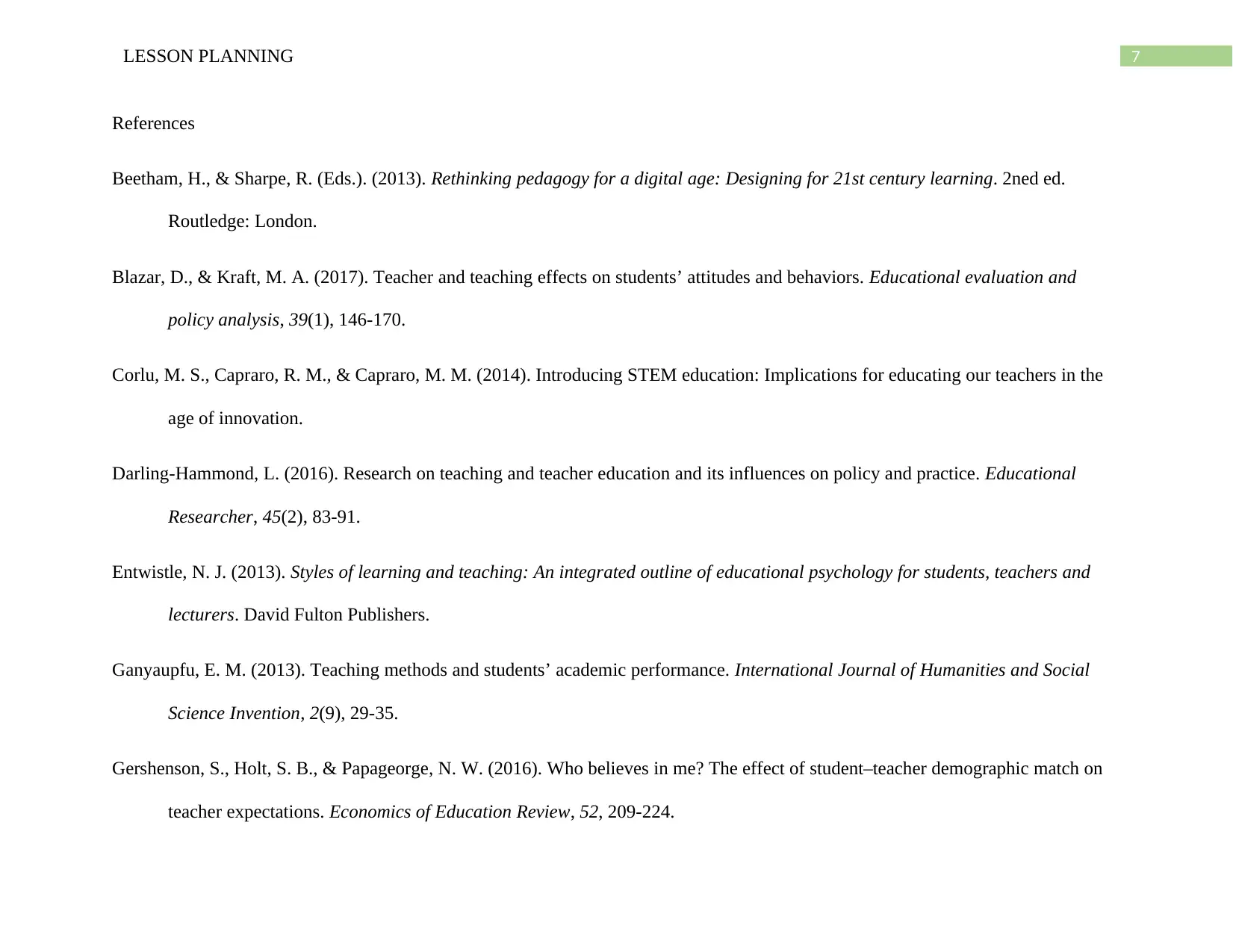
7LESSON PLANNING
References
Beetham, H., & Sharpe, R. (Eds.). (2013). Rethinking pedagogy for a digital age: Designing for 21st century learning. 2ned ed.
Routledge: London.
Blazar, D., & Kraft, M. A. (2017). Teacher and teaching effects on students’ attitudes and behaviors. Educational evaluation and
policy analysis, 39(1), 146-170.
Corlu, M. S., Capraro, R. M., & Capraro, M. M. (2014). Introducing STEM education: Implications for educating our teachers in the
age of innovation.
Darling-Hammond, L. (2016). Research on teaching and teacher education and its influences on policy and practice. Educational
Researcher, 45(2), 83-91.
Entwistle, N. J. (2013). Styles of learning and teaching: An integrated outline of educational psychology for students, teachers and
lecturers. David Fulton Publishers.
Ganyaupfu, E. M. (2013). Teaching methods and students’ academic performance. International Journal of Humanities and Social
Science Invention, 2(9), 29-35.
Gershenson, S., Holt, S. B., & Papageorge, N. W. (2016). Who believes in me? The effect of student–teacher demographic match on
teacher expectations. Economics of Education Review, 52, 209-224.
References
Beetham, H., & Sharpe, R. (Eds.). (2013). Rethinking pedagogy for a digital age: Designing for 21st century learning. 2ned ed.
Routledge: London.
Blazar, D., & Kraft, M. A. (2017). Teacher and teaching effects on students’ attitudes and behaviors. Educational evaluation and
policy analysis, 39(1), 146-170.
Corlu, M. S., Capraro, R. M., & Capraro, M. M. (2014). Introducing STEM education: Implications for educating our teachers in the
age of innovation.
Darling-Hammond, L. (2016). Research on teaching and teacher education and its influences on policy and practice. Educational
Researcher, 45(2), 83-91.
Entwistle, N. J. (2013). Styles of learning and teaching: An integrated outline of educational psychology for students, teachers and
lecturers. David Fulton Publishers.
Ganyaupfu, E. M. (2013). Teaching methods and students’ academic performance. International Journal of Humanities and Social
Science Invention, 2(9), 29-35.
Gershenson, S., Holt, S. B., & Papageorge, N. W. (2016). Who believes in me? The effect of student–teacher demographic match on
teacher expectations. Economics of Education Review, 52, 209-224.
Paraphrase This Document
Need a fresh take? Get an instant paraphrase of this document with our AI Paraphraser
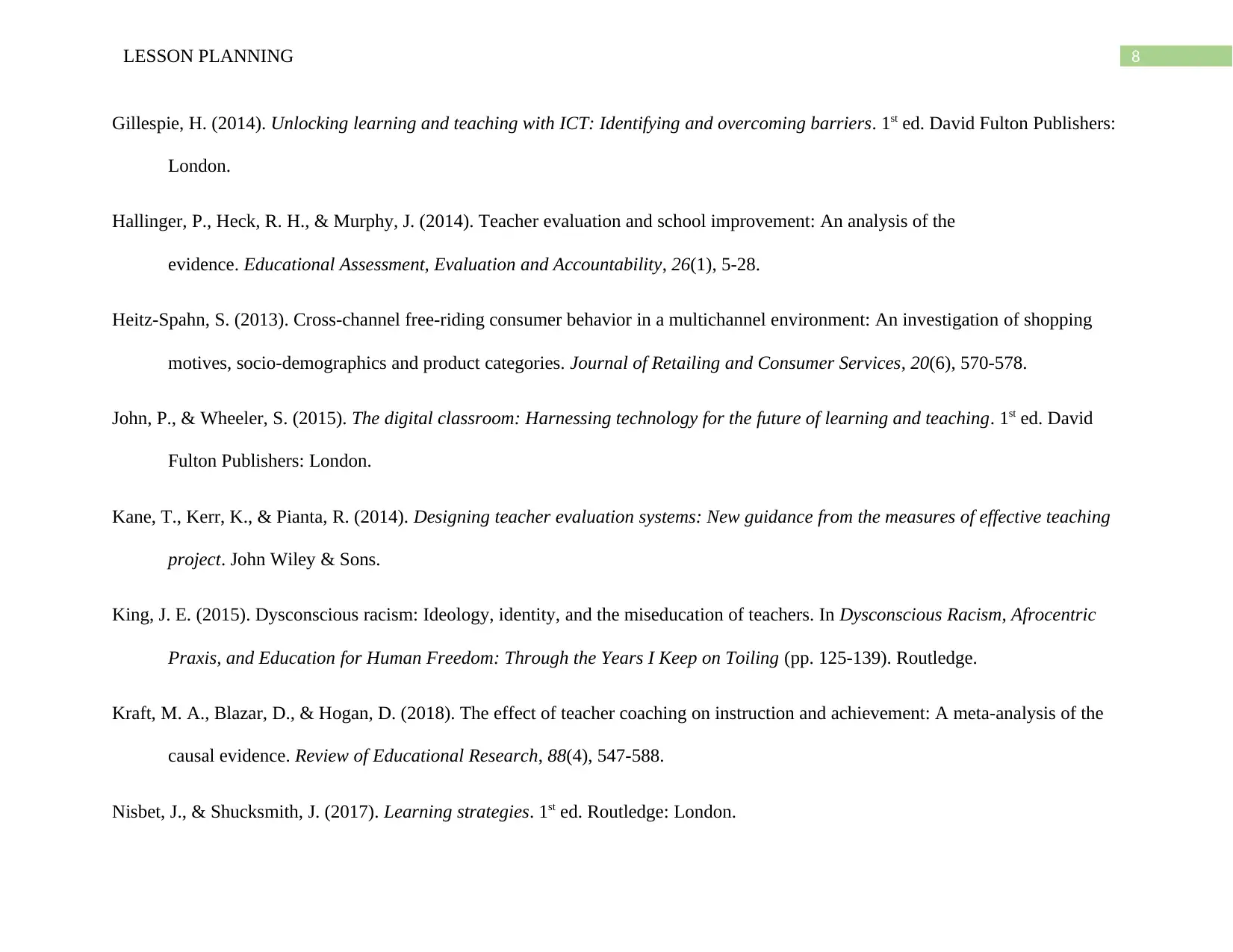
8LESSON PLANNING
Gillespie, H. (2014). Unlocking learning and teaching with ICT: Identifying and overcoming barriers. 1st ed. David Fulton Publishers:
London.
Hallinger, P., Heck, R. H., & Murphy, J. (2014). Teacher evaluation and school improvement: An analysis of the
evidence. Educational Assessment, Evaluation and Accountability, 26(1), 5-28.
Heitz-Spahn, S. (2013). Cross-channel free-riding consumer behavior in a multichannel environment: An investigation of shopping
motives, socio-demographics and product categories. Journal of Retailing and Consumer Services, 20(6), 570-578.
John, P., & Wheeler, S. (2015). The digital classroom: Harnessing technology for the future of learning and teaching. 1st ed. David
Fulton Publishers: London.
Kane, T., Kerr, K., & Pianta, R. (2014). Designing teacher evaluation systems: New guidance from the measures of effective teaching
project. John Wiley & Sons.
King, J. E. (2015). Dysconscious racism: Ideology, identity, and the miseducation of teachers. In Dysconscious Racism, Afrocentric
Praxis, and Education for Human Freedom: Through the Years I Keep on Toiling (pp. 125-139). Routledge.
Kraft, M. A., Blazar, D., & Hogan, D. (2018). The effect of teacher coaching on instruction and achievement: A meta-analysis of the
causal evidence. Review of Educational Research, 88(4), 547-588.
Nisbet, J., & Shucksmith, J. (2017). Learning strategies. 1st ed. Routledge: London.
Gillespie, H. (2014). Unlocking learning and teaching with ICT: Identifying and overcoming barriers. 1st ed. David Fulton Publishers:
London.
Hallinger, P., Heck, R. H., & Murphy, J. (2014). Teacher evaluation and school improvement: An analysis of the
evidence. Educational Assessment, Evaluation and Accountability, 26(1), 5-28.
Heitz-Spahn, S. (2013). Cross-channel free-riding consumer behavior in a multichannel environment: An investigation of shopping
motives, socio-demographics and product categories. Journal of Retailing and Consumer Services, 20(6), 570-578.
John, P., & Wheeler, S. (2015). The digital classroom: Harnessing technology for the future of learning and teaching. 1st ed. David
Fulton Publishers: London.
Kane, T., Kerr, K., & Pianta, R. (2014). Designing teacher evaluation systems: New guidance from the measures of effective teaching
project. John Wiley & Sons.
King, J. E. (2015). Dysconscious racism: Ideology, identity, and the miseducation of teachers. In Dysconscious Racism, Afrocentric
Praxis, and Education for Human Freedom: Through the Years I Keep on Toiling (pp. 125-139). Routledge.
Kraft, M. A., Blazar, D., & Hogan, D. (2018). The effect of teacher coaching on instruction and achievement: A meta-analysis of the
causal evidence. Review of Educational Research, 88(4), 547-588.
Nisbet, J., & Shucksmith, J. (2017). Learning strategies. 1st ed. Routledge: London.

9LESSON PLANNING
Perrott, E. (2014). Effective teaching: A practical guide to improving your teaching. 1st ed. Routledge: London.
Roach, T. (2014). Student perceptions toward flipped learning: New methods to increase interaction and active learning in
economics. International review of economics education, 17, 74-84.
Roehl, A., Reddy, S. L., & Shannon, G. J. (2013). The flipped classroom: An opportunity to engage millennial students through active
learning strategies. Journal of Family & Consumer Sciences, 105(2), 44-49.
Ronfeldt, M., Farmer, S. O., McQueen, K., & Grissom, J. A. (2015). Teacher collaboration in instructional teams and student
achievement. American Educational Research Journal, 52(3), 475-514.
Sun, M., Penuel, W. R., Frank, K. A., Gallagher, H. A., & Youngs, P. (2013). Shaping professional development to promote the
diffusion of instructional expertise among teachers. Educational Evaluation and Policy Analysis, 35(3), 344-369.
Voogt, J., Knezek, G., Cox, M., Knezek, D., & ten Brummelhuis, A. (2013). Under which conditions does ICT have a positive effect
on teaching and learning? A Call to Action. Journal of computer assisted learning, 29(1), 4-14.
Yin, H. B., Lee, J. C. K., & Zhang, Z. H. (2013). Exploring the relationship among teachers' emotional intelligence, emotional labor
strategies and teaching satisfaction. Teaching and Teacher Education, 35, 137-145.
Perrott, E. (2014). Effective teaching: A practical guide to improving your teaching. 1st ed. Routledge: London.
Roach, T. (2014). Student perceptions toward flipped learning: New methods to increase interaction and active learning in
economics. International review of economics education, 17, 74-84.
Roehl, A., Reddy, S. L., & Shannon, G. J. (2013). The flipped classroom: An opportunity to engage millennial students through active
learning strategies. Journal of Family & Consumer Sciences, 105(2), 44-49.
Ronfeldt, M., Farmer, S. O., McQueen, K., & Grissom, J. A. (2015). Teacher collaboration in instructional teams and student
achievement. American Educational Research Journal, 52(3), 475-514.
Sun, M., Penuel, W. R., Frank, K. A., Gallagher, H. A., & Youngs, P. (2013). Shaping professional development to promote the
diffusion of instructional expertise among teachers. Educational Evaluation and Policy Analysis, 35(3), 344-369.
Voogt, J., Knezek, G., Cox, M., Knezek, D., & ten Brummelhuis, A. (2013). Under which conditions does ICT have a positive effect
on teaching and learning? A Call to Action. Journal of computer assisted learning, 29(1), 4-14.
Yin, H. B., Lee, J. C. K., & Zhang, Z. H. (2013). Exploring the relationship among teachers' emotional intelligence, emotional labor
strategies and teaching satisfaction. Teaching and Teacher Education, 35, 137-145.
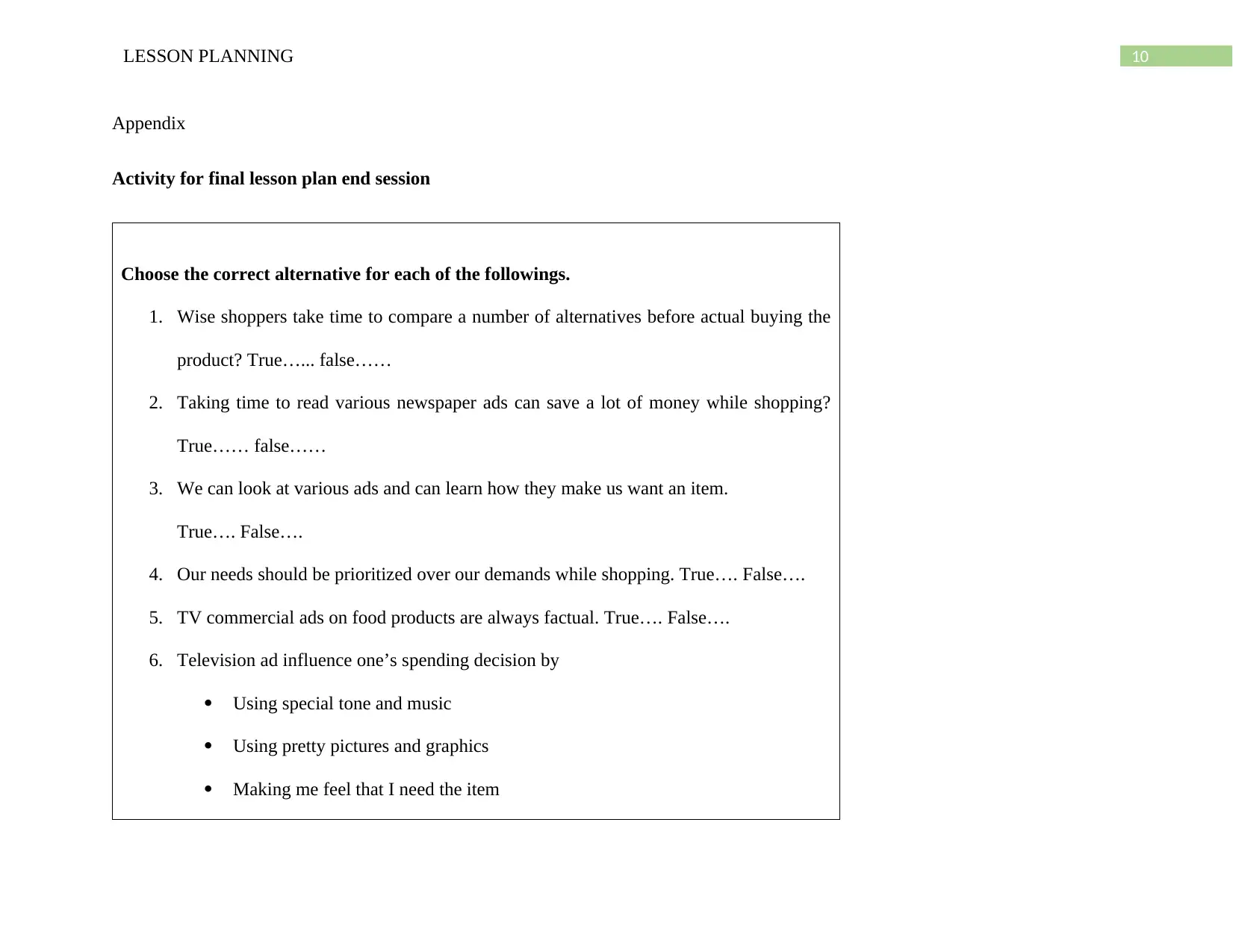
10LESSON PLANNING
Appendix
Activity for final lesson plan end session
Choose the correct alternative for each of the followings.
1. Wise shoppers take time to compare a number of alternatives before actual buying the
product? True…... false……
2. Taking time to read various newspaper ads can save a lot of money while shopping?
True…… false……
3. We can look at various ads and can learn how they make us want an item.
True…. False….
4. Our needs should be prioritized over our demands while shopping. True…. False….
5. TV commercial ads on food products are always factual. True…. False….
6. Television ad influence one’s spending decision by
Using special tone and music
Using pretty pictures and graphics
Making me feel that I need the item
Appendix
Activity for final lesson plan end session
Choose the correct alternative for each of the followings.
1. Wise shoppers take time to compare a number of alternatives before actual buying the
product? True…... false……
2. Taking time to read various newspaper ads can save a lot of money while shopping?
True…… false……
3. We can look at various ads and can learn how they make us want an item.
True…. False….
4. Our needs should be prioritized over our demands while shopping. True…. False….
5. TV commercial ads on food products are always factual. True…. False….
6. Television ad influence one’s spending decision by
Using special tone and music
Using pretty pictures and graphics
Making me feel that I need the item
Secure Best Marks with AI Grader
Need help grading? Try our AI Grader for instant feedback on your assignments.
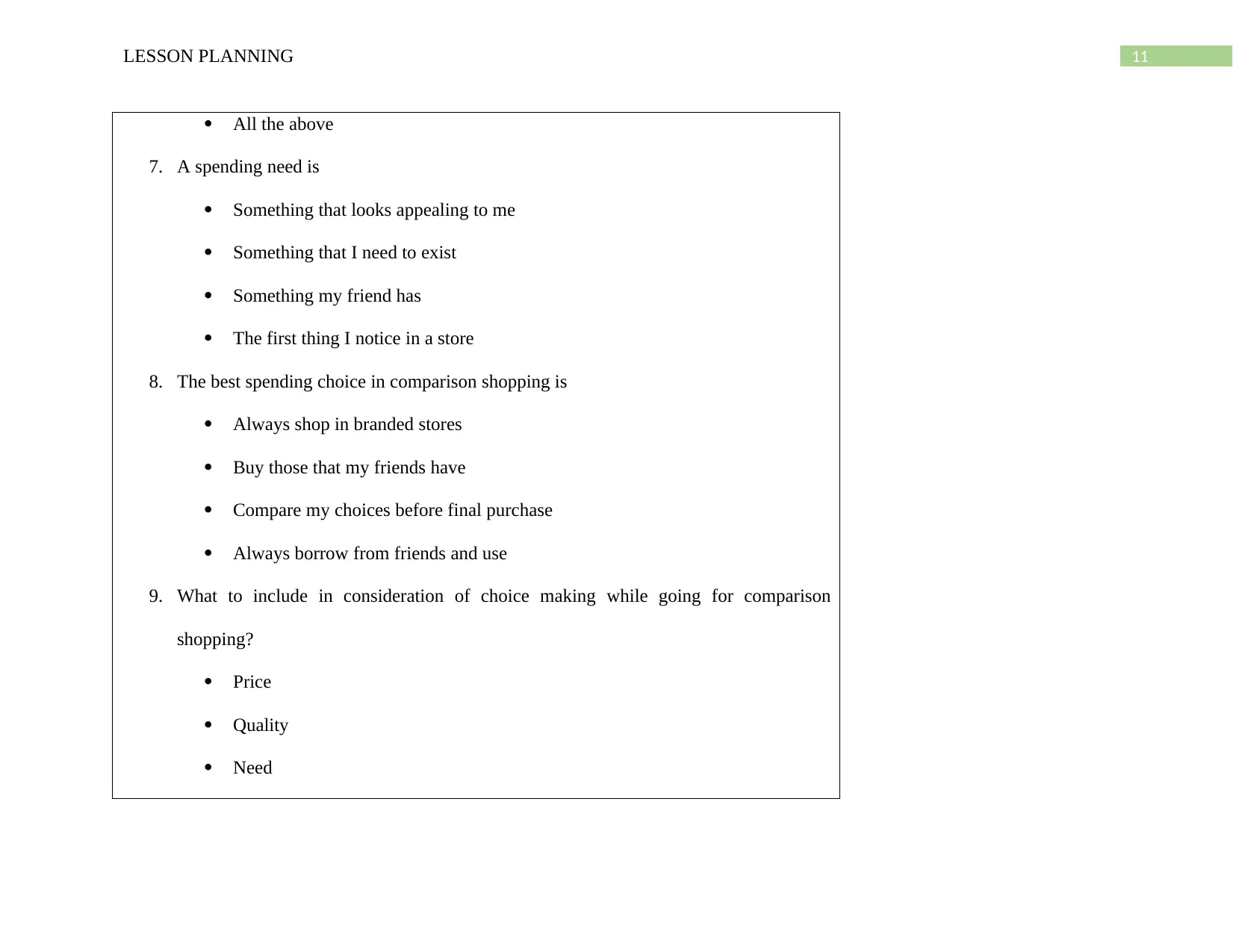
11LESSON PLANNING
All the above
7. A spending need is
Something that looks appealing to me
Something that I need to exist
Something my friend has
The first thing I notice in a store
8. The best spending choice in comparison shopping is
Always shop in branded stores
Buy those that my friends have
Compare my choices before final purchase
Always borrow from friends and use
9. What to include in consideration of choice making while going for comparison
shopping?
Price
Quality
Need
All the above
7. A spending need is
Something that looks appealing to me
Something that I need to exist
Something my friend has
The first thing I notice in a store
8. The best spending choice in comparison shopping is
Always shop in branded stores
Buy those that my friends have
Compare my choices before final purchase
Always borrow from friends and use
9. What to include in consideration of choice making while going for comparison
shopping?
Price
Quality
Need
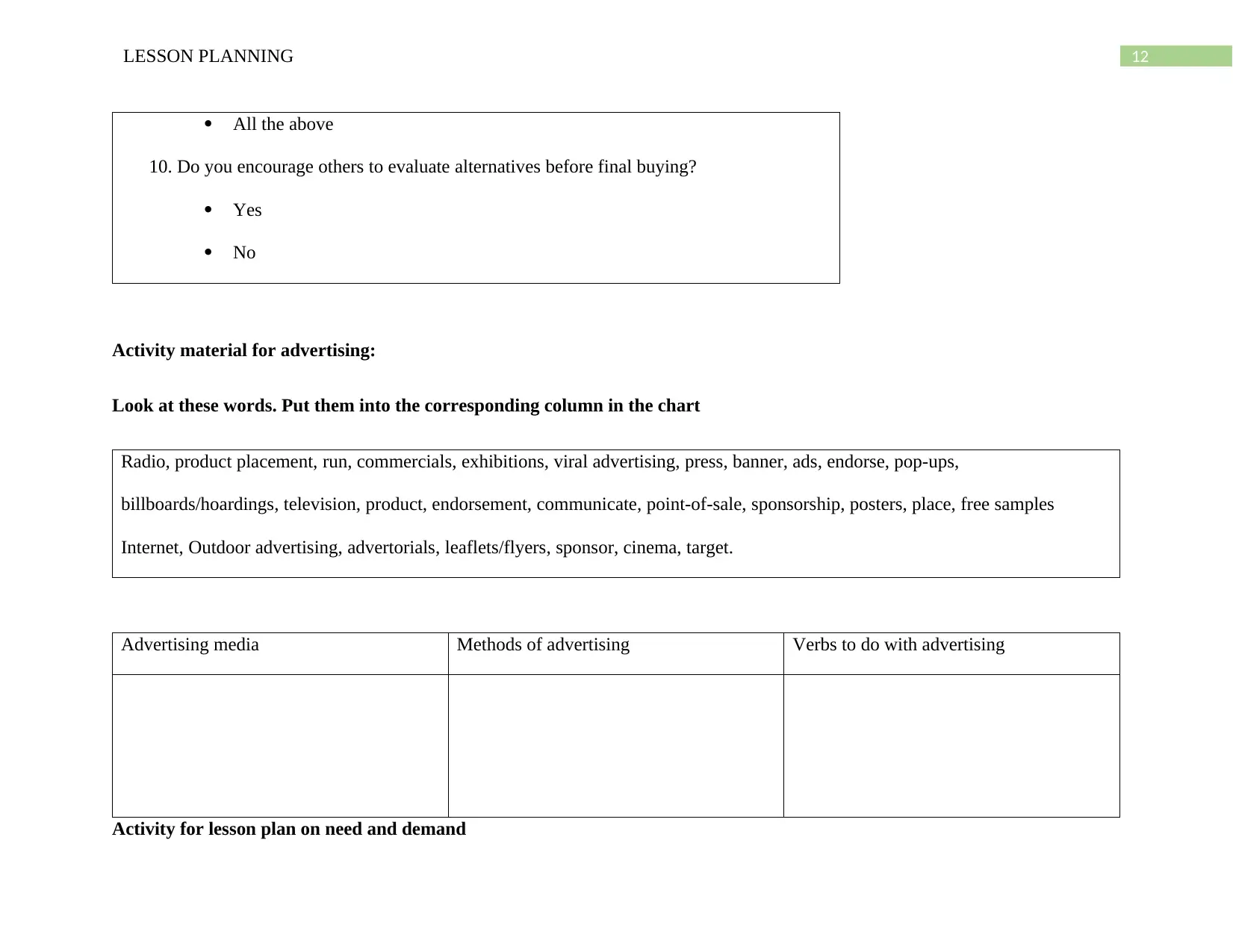
12LESSON PLANNING
All the above
10. Do you encourage others to evaluate alternatives before final buying?
Yes
No
Activity material for advertising:
Look at these words. Put them into the corresponding column in the chart
Radio, product placement, run, commercials, exhibitions, viral advertising, press, banner, ads, endorse, pop-ups,
billboards/hoardings, television, product, endorsement, communicate, point-of-sale, sponsorship, posters, place, free samples
Internet, Outdoor advertising, advertorials, leaflets/flyers, sponsor, cinema, target.
Advertising media Methods of advertising Verbs to do with advertising
Activity for lesson plan on need and demand
All the above
10. Do you encourage others to evaluate alternatives before final buying?
Yes
No
Activity material for advertising:
Look at these words. Put them into the corresponding column in the chart
Radio, product placement, run, commercials, exhibitions, viral advertising, press, banner, ads, endorse, pop-ups,
billboards/hoardings, television, product, endorsement, communicate, point-of-sale, sponsorship, posters, place, free samples
Internet, Outdoor advertising, advertorials, leaflets/flyers, sponsor, cinema, target.
Advertising media Methods of advertising Verbs to do with advertising
Activity for lesson plan on need and demand

13LESSON PLANNING
Students need to fill this for their last month purchase considerations
Students need to fill this for their last month purchase considerations
Paraphrase This Document
Need a fresh take? Get an instant paraphrase of this document with our AI Paraphraser
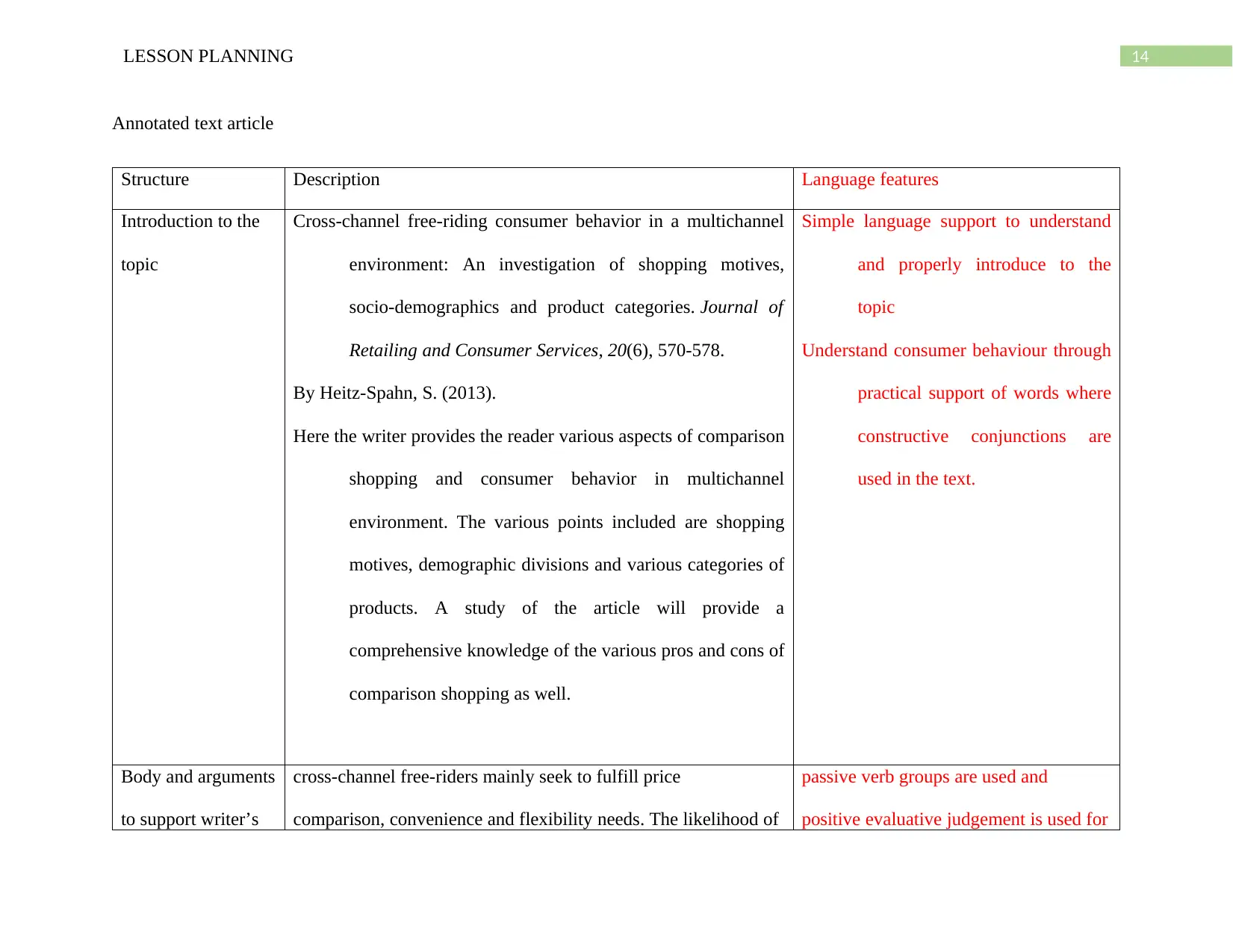
14LESSON PLANNING
Annotated text article
Structure Description Language features
Introduction to the
topic
Cross-channel free-riding consumer behavior in a multichannel
environment: An investigation of shopping motives,
socio-demographics and product categories. Journal of
Retailing and Consumer Services, 20(6), 570-578.
By Heitz-Spahn, S. (2013).
Here the writer provides the reader various aspects of comparison
shopping and consumer behavior in multichannel
environment. The various points included are shopping
motives, demographic divisions and various categories of
products. A study of the article will provide a
comprehensive knowledge of the various pros and cons of
comparison shopping as well.
Simple language support to understand
and properly introduce to the
topic
Understand consumer behaviour through
practical support of words where
constructive conjunctions are
used in the text.
Body and arguments
to support writer’s
cross-channel free-riders mainly seek to fulfill price
comparison, convenience and flexibility needs. The likelihood of
passive verb groups are used and
positive evaluative judgement is used for
Annotated text article
Structure Description Language features
Introduction to the
topic
Cross-channel free-riding consumer behavior in a multichannel
environment: An investigation of shopping motives,
socio-demographics and product categories. Journal of
Retailing and Consumer Services, 20(6), 570-578.
By Heitz-Spahn, S. (2013).
Here the writer provides the reader various aspects of comparison
shopping and consumer behavior in multichannel
environment. The various points included are shopping
motives, demographic divisions and various categories of
products. A study of the article will provide a
comprehensive knowledge of the various pros and cons of
comparison shopping as well.
Simple language support to understand
and properly introduce to the
topic
Understand consumer behaviour through
practical support of words where
constructive conjunctions are
used in the text.
Body and arguments
to support writer’s
cross-channel free-riders mainly seek to fulfill price
comparison, convenience and flexibility needs. The likelihood of
passive verb groups are used and
positive evaluative judgement is used for

15LESSON PLANNING
claim free-riding is higher when
consumers adopt cross-channel rather than single-channel
behavior, which highlights a
negative outcome of multichannel retailing.
cross-channel free-riders mainly seek to fulfill price
comparison, convenience and flexibility needs. The likelihood of
free-riding is higher when
consumers adopt cross-channel rather than single-channel
behavior, which highlights a
negative outcome of multichannel retailing.
Study of various aspects of comparison shows that cross-channel
free consumers seek to fulfil mainly their aspects of price,
comparison, flexibility needs and convenience.
Comparison shopping has higher degree of free-channel
riders which is a negative aspect of it. Thus, customer
retention becomes difficult and customer loyalty in the
brand also decreases considerably. But it is also true that
contrastive comparison.
Various verb forms and group word
syntaxes are used to increase richness of
word knowhow.
claim free-riding is higher when
consumers adopt cross-channel rather than single-channel
behavior, which highlights a
negative outcome of multichannel retailing.
cross-channel free-riders mainly seek to fulfill price
comparison, convenience and flexibility needs. The likelihood of
free-riding is higher when
consumers adopt cross-channel rather than single-channel
behavior, which highlights a
negative outcome of multichannel retailing.
Study of various aspects of comparison shows that cross-channel
free consumers seek to fulfil mainly their aspects of price,
comparison, flexibility needs and convenience.
Comparison shopping has higher degree of free-channel
riders which is a negative aspect of it. Thus, customer
retention becomes difficult and customer loyalty in the
brand also decreases considerably. But it is also true that
contrastive comparison.
Various verb forms and group word
syntaxes are used to increase richness of
word knowhow.
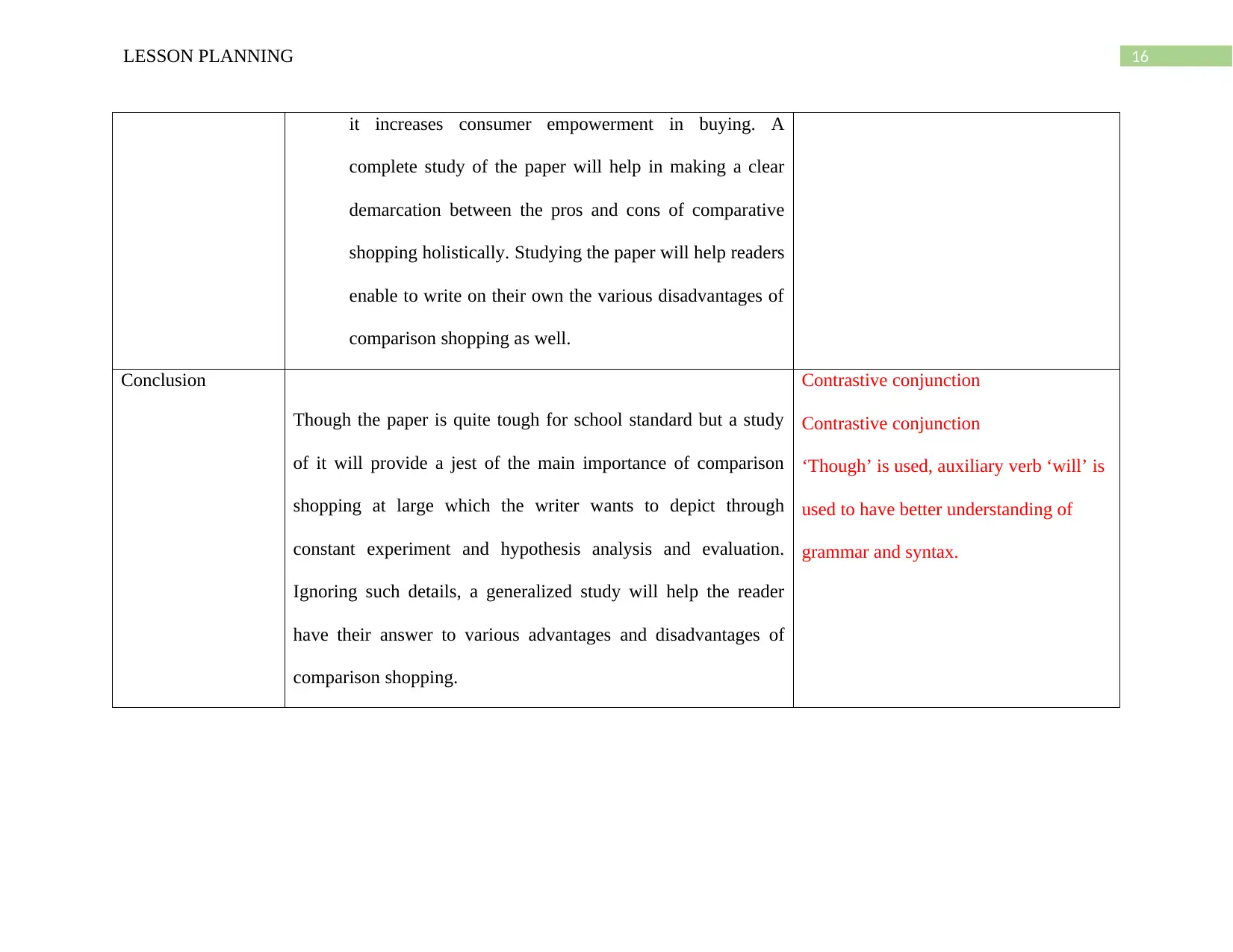
16LESSON PLANNING
it increases consumer empowerment in buying. A
complete study of the paper will help in making a clear
demarcation between the pros and cons of comparative
shopping holistically. Studying the paper will help readers
enable to write on their own the various disadvantages of
comparison shopping as well.
Conclusion
Though the paper is quite tough for school standard but a study
of it will provide a jest of the main importance of comparison
shopping at large which the writer wants to depict through
constant experiment and hypothesis analysis and evaluation.
Ignoring such details, a generalized study will help the reader
have their answer to various advantages and disadvantages of
comparison shopping.
Contrastive conjunction
Contrastive conjunction
‘Though’ is used, auxiliary verb ‘will’ is
used to have better understanding of
grammar and syntax.
it increases consumer empowerment in buying. A
complete study of the paper will help in making a clear
demarcation between the pros and cons of comparative
shopping holistically. Studying the paper will help readers
enable to write on their own the various disadvantages of
comparison shopping as well.
Conclusion
Though the paper is quite tough for school standard but a study
of it will provide a jest of the main importance of comparison
shopping at large which the writer wants to depict through
constant experiment and hypothesis analysis and evaluation.
Ignoring such details, a generalized study will help the reader
have their answer to various advantages and disadvantages of
comparison shopping.
Contrastive conjunction
Contrastive conjunction
‘Though’ is used, auxiliary verb ‘will’ is
used to have better understanding of
grammar and syntax.
1 out of 16
Related Documents
Your All-in-One AI-Powered Toolkit for Academic Success.
+13062052269
info@desklib.com
Available 24*7 on WhatsApp / Email
![[object Object]](/_next/static/media/star-bottom.7253800d.svg)
Unlock your academic potential
© 2024 | Zucol Services PVT LTD | All rights reserved.





